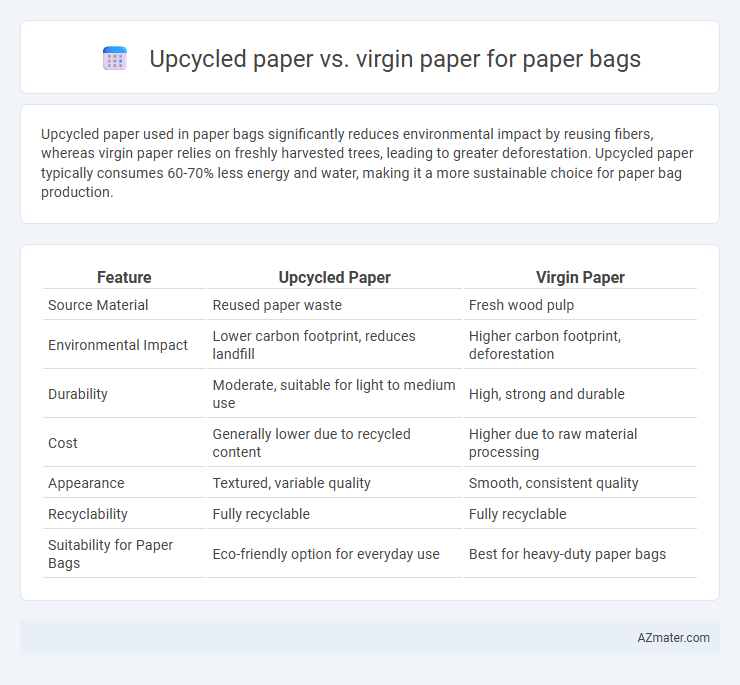Upcycled paper used in paper bags significantly reduces environmental impact by reusing fibers, whereas virgin paper relies on freshly harvested trees, leading to greater deforestation. Upcycled paper typically consumes 60-70% less energy and water, making it a more sustainable choice for paper bag production.
Table of Comparison
| Feature | Upcycled Paper | Virgin Paper |
|---|---|---|
| Source Material | Reused paper waste | Fresh wood pulp |
| Environmental Impact | Lower carbon footprint, reduces landfill | Higher carbon footprint, deforestation |
| Durability | Moderate, suitable for light to medium use | High, strong and durable |
| Cost | Generally lower due to recycled content | Higher due to raw material processing |
| Appearance | Textured, variable quality | Smooth, consistent quality |
| Recyclability | Fully recyclable | Fully recyclable |
| Suitability for Paper Bags | Eco-friendly option for everyday use | Best for heavy-duty paper bags |
Introduction to Upcycled Paper and Virgin Paper
Upcycled paper is produced by repurposing used paper materials, reducing waste and conserving natural resources, making it an eco-friendly choice for paper bags. Virgin paper is made from fresh wood pulp, ensuring high strength and quality but with a higher environmental impact due to deforestation and energy consumption. Choosing upcycled paper for paper bags supports sustainability efforts by minimizing landfill contributions and lowering carbon footprints compared to traditional virgin paper.
Environmental Impact: Upcycled vs Virgin Paper
Upcycled paper for paper bags significantly reduces environmental impact by lowering deforestation rates and minimizing water and energy consumption during production compared to virgin paper. Using upcycled paper decreases landfill waste and reduces greenhouse gas emissions by repurposing existing fibers rather than manufacturing from raw wood pulp. In contrast, virgin paper production demands extensive natural resource extraction and generates higher carbon footprints, making upcycled paper a more sustainable choice for eco-conscious packaging.
Raw Materials and Production Processes
Upcycled paper for paper bags utilizes recycled fibers from previously used paper products, significantly reducing the demand for fresh raw materials and lowering environmental impact. Virgin paper is made from wood pulp derived directly from trees, requiring intensive harvesting, chemical processing, and higher water and energy consumption in production. The production process of upcycled paper involves de-inking, cleaning, and re-pulping, which conserves resources compared to the mechanical and chemical treatments needed to transform virgin wood into clean pulp for paper bags.
Energy and Resource Consumption
Upcycled paper used for paper bags significantly reduces energy consumption by up to 60% compared to virgin paper production, which requires extensive processing of raw wood pulp. Resource consumption is minimized as upcycled paper relies on repurposed fibers, decreasing the demand for fresh timber and lowering water usage by approximately 50%. This sustainable choice helps conserve natural resources and lowers the environmental footprint associated with paper bag manufacturing.
Quality and Durability Comparison
Upcycled paper bags offer a sustainable alternative but typically exhibit lower tensile strength and durability compared to virgin paper bags, which are made from fresh fibers ensuring higher quality and sturdiness. Virgin paper bags provide better tear resistance and moisture tolerance, making them more suitable for carrying heavier loads and prolonged use. The manufacturing process of virgin paper also results in a smoother texture and consistent thickness, enhancing the overall quality and performance of the paper bag.
Cost Analysis: Upcycled Paper vs Virgin Paper
Upcycled paper for paper bags significantly reduces raw material costs due to the use of recycled fibers, lowering production expenses compared to virgin paper made from fresh pulp. Virgin paper incurs higher costs from the energy-intensive pulping process and sourcing of new wood fibers, resulting in a more expensive manufacturing cycle. Overall, upcycled paper offers a cost-effective solution that aligns with sustainable practices while maintaining quality standards.
Aesthetic Appeal and Customization Options
Upcycled paper for paper bags offers a unique, rustic aesthetic characterized by natural textures and color variations, appealing to eco-conscious brands seeking an artisanal look. Virgin paper, known for its smooth, consistent surface and bright whiteness, provides superior print clarity and vibrant color reproduction, enhancing intricate designs and detailed logos. Customization options on virgin paper are more extensive, including embossing, debossing, and a wider range of finishes, while upcycled paper customization tends to emphasize organic patterns and limited color palettes due to its recycled fibers.
Consumer Perceptions and Market Demand
Consumers increasingly prefer upcycled paper for paper bags due to its eco-friendly attributes and reduced environmental impact, driving higher market demand for sustainable packaging options. Virgin paper, while often perceived as higher quality and more durable, faces criticism for deforestation and higher carbon footprints. Market trends indicate a shift toward upcycled paper products as brands and consumers prioritize circular economy principles and sustainable sourcing.
Regulatory and Certification Considerations
Upcycled paper for paper bags often carries certifications such as FSC Recycled or SFI Recycled, ensuring compliance with environmental regulations and promoting sustainable resource use, while virgin paper typically holds FSC or PEFC certification guaranteeing responsible forest management. Regulatory frameworks in many regions require paper bags to meet specific biodegradability and recyclability standards that both upcycled and virgin paper fibers must adhere to, influencing material choice. Certification schemes like the EU Ecolabel and USDA Biobased Product Certification also play critical roles in validating the environmental claims of paper bags made from either upcycled or virgin pulp.
Choosing the Right Paper for Your Paper Bags
Upcycled paper for paper bags reduces environmental impact by reusing fibers from post-consumer waste, offering an eco-friendly alternative to virgin paper, which is made from freshly harvested wood pulp and provides higher strength and durability. Selecting the right paper depends on balancing sustainability goals with functional requirements such as bag strength, print quality, and cost-effectiveness. For lightweight, everyday bags, upcycled paper delivers sufficient performance, while premium or heavier-duty bags benefit from the superior tear resistance and smooth finish of virgin paper.

Infographic: Upcycled paper vs Virgin paper for Paper bag
 azmater.com
azmater.com